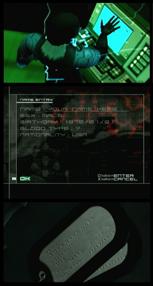MGS2 kinked the Solid Map when it made the actor himself know the Map, but
MGS2 made clear that Raiden was not Solid Snake. Despite his effort to play the part, Raiden revealed his unique personality. He admitted early in the Plant Chapter that he would leave the battlefield at once if he could—the same battlefield that Snake had called home in
MGS1. In MGS1, Snake had expressed interest in others only as they related to his mission, yet Raiden told his C. O. that the lives of thirty hostages were more important to him than his mission to rescue the President. At the end of the game, he argued with his superiors and asserted his right to choose
not to fight the terrorists’ leader.
Raiden’s protests became moot, and the political philosophy of Percy Shelley offers insight why. Shelley wrote that individuals must often submit to unavoidable, coercive forces despite their individual wills, even while they themselves help to create those forces by living within society. Individuals must submit to societal pressures (such as civic law) if they want to remain part of society.
Shelley hit Raiden’s dilemma on the head. The Scenario Map required Raiden’s submission to the Solid Map because he could not have survived the events preceding MGS2’s climax had he not fought like Solid Snake. Moreover, Raiden wanted to be himself and Solid Snake at the same time. Unable to act as both, he filed his grievances and submitted to the Solid Map. Raiden enforced the self-deception demanded by his circumstances.

|
MGS1’s narrative had forced Solid Snake to fail before he could succeed, just as videogames force players to fail before they succeed. The player had failed many times against Psycho Mantis until the fictional support staff told him to switch the controller’s port, just as Snake had failed to defeat Rex until a fictional supporting character made it possible to defeat Rex. The player could happily identify with Snake because they had shared parallel frustrations and redemptions. MGS1 had created its form when its narrative mimicked the player’s experience with the game.
MGS2’s form, however, wed the player to an actor whose frustrations he shared without redemption. Whenever Raiden and the player handled
MGS1’s remixed forms, they barely treaded water. None of the supersoldiers necessarily died. Arsenal Gear totally destroyed the cleanup facility that the two had worked so hard to save from Fatman’s bombs. Both player and actor shared the desire to obey a fantasy that ironically
bound them together via shared failure rather than to their hero by a shared pattern of failure and success.